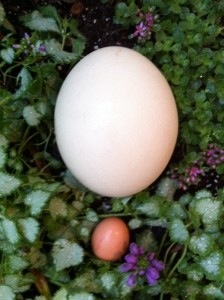 My family prides itself on searching out unique gifts. One of my sons gave his father an ostrich egg for Father’s Day. It’s the giant cream colored egg in the photo with a large brown hen’s egg next to it for a size comparison. He bought the egg from an alpaca and ostrich farmer selling his wares (not live animals!) at the outdoor market in front of the Museum of Natural History in New York City.
My family prides itself on searching out unique gifts. One of my sons gave his father an ostrich egg for Father’s Day. It’s the giant cream colored egg in the photo with a large brown hen’s egg next to it for a size comparison. He bought the egg from an alpaca and ostrich farmer selling his wares (not live animals!) at the outdoor market in front of the Museum of Natural History in New York City.
A Giant Heavy Hard-Shelled Egg
An ostrich, native to South Africa, is flightless, fast-running, and the world’s largest living bird. An ostrich egg is the largest egg produced by a living creature (a dinosaur egg in the American Museum of Natural History is about the size of basketball), weighing in at around 3.3 pounds (about 20 times the weight of a chicken egg). Its yolk is the largest single cell that currently exists.
The egg is glossy and cream colored, with a thick hard pitted shell (like a golf ball) — hard enough for a 300 pound bird to sit on it. It is incubated by females during the day and by males at night. One egg is equivalent to about 18 to 24 chicken eggs — and yes, you can make a gigantic ostrich egg omelet (after using a drill to get through the hard shell). Females lay their fertilized eggs in a single communal nest that has been scraped in the ground by a male. The dominant female is the first to lay her eggs and she discards extra eggs from weaker females, leaving about 20 in the nest.




